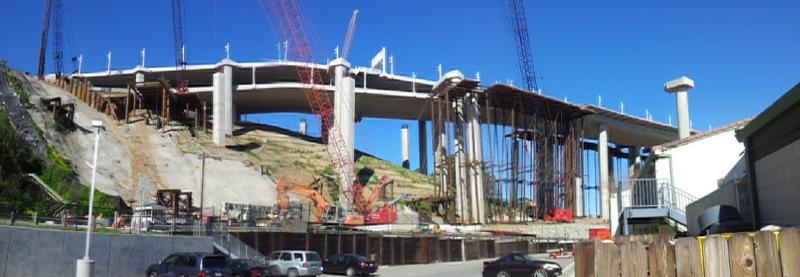We had a very interesting tour of the San Francisco Vessel Traffic Services branch of the USCG on Yerba Buena Island yesterday. There were eight of us for the tour and briefing which lasted about an hour.
After signing in, we entered the VTS Ops Center which is a single room about 1000 sq ft (rough guess...maybe 32x32). There are several large video monitors set up in stations around the room, each with 5-6 screens with various displays of video cameras, AIS A overlaid on a NOAA chart, AIS B on a NOAA chart, raw radar returns of the Area of Responsibility (AOR) as well as other relevant data.
One specialist handles offshore traffic and another handles the bay and river traffic. There are other positions for coordination and supervision with a max staffing of about 5 or 6 specialists and supervisors.
The AOR extends from about 30 miles outside the Golden Gate and inland as far as the ports of Stockton to the east and Sacramento to the north and Dumbarton Bridge to the south. CWO Warren Weatherford briefed us on the mission, tools and methods used by VTS to provide both security and safety for the public recreational and commercial traffic in the AOR.
Their focus is on security and commercial traffic services. They provide advisories of other known traffic along a ship's course and any Notices to Mariners or No Wake zones in the area. If there are temporary restriction to travel in an area, for example bridge construction or destruction as we're seeing now on the Bay Bridge or SAR operations, they will pass along this information for those on the frequency.
We wanted to know if their services were available to recreational boaters transiting the area and were told yes, we are welcome to check in for traffic, notice and weather advisories or, workload permitting, tracking services during periods of low visibility. It doesn't hurt to ask and if it's too busy, they'll advise.
Some of their capabilities were predictable and others had a certain "Wow" factor. The Class A AIS display was expected and we learned that to eliminate some of the unneeded clutter (like fishing fleets out at sea), they utilize filters to thin the targets to what they need. Many of these targets are color coded to provide immediate awareness to mission, petroleum products cargo, etc. A separate display showed the Class B AIS targets in case someone checks in for services with just Class B AIS.
A third display I was hoping they'd have was the raw radar which allowed them to see the radar returns on all traffic in the bays and straits as far east as Carquinez Strait. East of that point, the terrain shielding restricts the radar coverage.
The most impressive (to me) capability was the live video coverage with fully controllable cameras. We were there on a crystal clear day that was perfect to demonstrate this capability. They can pan and zoom these cameras which are strategically placed around the bay area. We saw a camera near the north end of the Golden Gate bridge zoomed in on a vessel passing the city front probably 3-5 miles away. It was a very impressive demo of their live video capability which is used for positive ID as well as SAR ops. So if I check in on the freq requesting trip traffic advisory services and have no AIS, they can correlate my position report with my boat description, confirm it's me (maybe by reading the transom name) and now they have positive ID on me. This video capability covers much of the SF and San Pablo Bays and extends as far east as Carquinez Strait. This eastern stretch of video coverage is provided from a camera near the mouth of Mare Island Strait. Other cameras in the SF Bay provide the western coverage.
Unlike Air Traffic Control where pilots on IFR flight plans are directed with specific headings, courses, altitudes and speeds, the commercial traffic is provided advisories of traffic in the area which might be a conflict and it's up to the Captains to work out their own collision avoidance maneuvers. They also provide up to the minute advisories on area ops of interest to local boaters, commercial and recreational alike.
I'm sure I'm leaving out lots of specifics and hope others on the trip with fill in the gaps. We were prohibited from taking photos so I asked for some unclassified photos to be sent to me for posting on this thread. They should arrive next week and I'll put them up when I get them.
In the meantime, here's what I have from our Day on the Bay.
(L-R Ray Muldrew - Giggitoni, Steve Ornoski, Matt Neumann - Pineapple Girl Guy, Al Kroeger - FlyWright, Mark Neumann, Richard Webber - Britannia, Mark Pierce, Bob Mills - remwines) There are some cutouts behind Ray and Bob...Ray's not carrying his weapon.
View of the Bay Bridge construction and destruction from USCG Sector SF.


